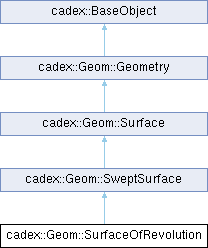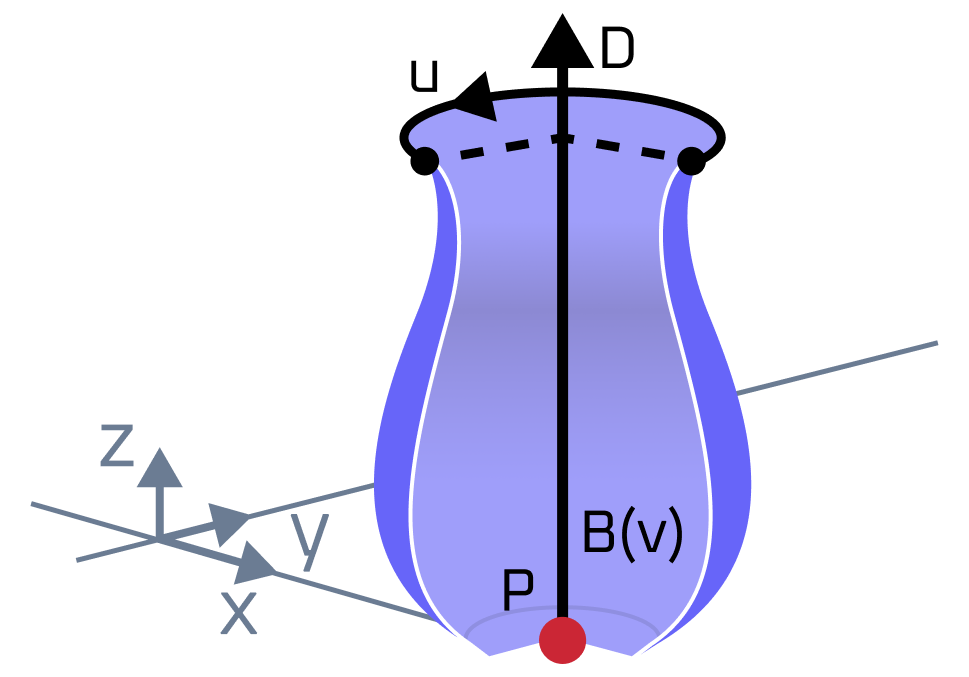Defines a surface of revolution. More...
#include <cadex/Geom/SurfaceOfRevolution.hxx>

Public Member Functions | |
| SurfaceOfRevolution () | |
| Constructor. | |
| SurfaceOfRevolution (const Geom::Curve &theBasisCurve, const Geom::Point &theLocation, const Geom::Direction &theDirection) | |
| Constructor. | |
| Geom::Point | Location () const |
| Returns an origin point of a rotation axis. | |
 Public Member Functions inherited from cadex::Geom::SweptSurface Public Member Functions inherited from cadex::Geom::SweptSurface | |
| SweptSurface () | |
| Constructor. | |
| Geom::Curve | BasisCurve () const |
| Geom::Direction | Direction () const |
 Public Member Functions inherited from cadex::Geom::Surface Public Member Functions inherited from cadex::Geom::Surface | |
| Surface () | |
| Constructor. | |
| SurfaceType | Type () const |
| Returns a surface type. | |
| Geom::Continuity | Continuity () const |
| Returns a continuity type of the surface. | |
| Point | Value (double theParameterU, double theParameterV) const |
| Evaluates a point on the surface. | |
| Direction | Normal (double theParameterU, double theParameterV) const |
| Returns the normal direction theNormal at the current point. | |
| bool | IsUPeriodic () const |
| Returns true if the surface is periodic in U direction. | |
| bool | IsVPeriodic () const |
| Returns true if the surface is periodic in V direction. | |
| double | UMin () const |
| Returns a minimum parameter of a definition domain in U direction. | |
| double | UMax () const |
| Returns a maximum parameter of a definition domain in U direction. | |
| double | VMin () const |
| Returns a minimum parameter of a definition domain in V direction. | |
| double | VMax () const |
| Returns a maximum parameter of a definition domain in V direction. | |
| void | Domain (double &theUMin, double &theUMax, double &theVMin, double &theVMax) const |
| Returns a definition domain. | |
| bool | IsTrimmed () const |
| Returns whether surface is trimmed or not. | |
| void | SetTrim (double theUFirst, double theULast, double theVFirst, double theVLast) |
| Trims surface with [theUFirst, theULast] x [theVFirst, theVLast] section. | |
| void | Transform (const Transformation &theTransformation) |
| Applies transformation matrix to this object. | |
| Surface | Transformed (const Transformation &theTransformation) const |
| Returns a copy this object after applying transformation. | |
| void | D0 (double theParameterU, double theParameterV, Point &theValue) const |
| Returns the point theValue of parameter theU, theV on the surface. | |
| void | D1 (double theParameterU, double theParameterV, Point &theValue, Vector &theD1U, Vector &theD1V) const |
| Returns the point theValue and the first derivatives in the directions U theD1U and V theD1V at this point. | |
| void | D2 (double theParameterU, double theParameterV, Point &theValue, Vector &theD1U, Vector &theD1V, Vector &theD2U, Vector &theD2V, Vector &theD2UV) const |
| Returns the point theValue, the first and the second derivatives in the directions U and V at this point. | |
| bool | DN (double theParameterU, double theParameterV, size_t theDerivativeOrder, Geom::Point &theValue, std::vector< Geom::Vector > &theD) const |
| void | Curvature (double theParameterU, double theParameterV, Direction &thePrincipalMaxDirection, Direction &thePrincipalMinDirection) const |
| Returns the max and min principal curvature directions multiplied by max and min value of curvature respectively. | |
| void | Curvature (double theParameterU, double theParameterV, Direction &thePrincipalMaxDirection, Direction &thePrincipalMinDirection, double &theMaxCurvature, double &theMinCurvature) const |
| Returns the max and min principal curvature directions and their values. | |
| void | Mirror (const Point &thePoint) |
| void | Mirror (const Axis1d &theAxis) |
| void | Mirror (const Axis3d &theAxis) |
| Surface | Mirrored (const Point &theRef) const |
| Surface | Mirrored (const Axis1d &theAxis) const |
| Surface | Mirrored (const Axis3d &theAxis) const |
| void | Rotate (const Axis1d &theAxis, double theAngle) |
| Surface | Rotated (const Axis1d &theAxis, double theAngle) const |
| void | Translate (const Vector &theVector) |
| Surface | Translated (const Vector &theVector) const |
| void | Scale (const Point &thePoint, double theScale) |
| Surface | Scaled (const Point &thePoint, double theScale) const |
 Public Member Functions inherited from cadex::BaseObject Public Member Functions inherited from cadex::BaseObject | |
| size_t | Id () const |
| Return unique identifier of public object. | |
| internal::BaseObjectImpl * | Impl () const |
| bool | IsNull () const |
| operator bool () const | |
| template<typename T > | |
| bool | IsOfType () const |
| template<typename T > | |
| T * | Impl () const |
| Reserved for internal use. | |
Static Public Member Functions | |
| static bool | CompareType (const BaseObject &theObject) |
 Static Public Member Functions inherited from cadex::Geom::SweptSurface Static Public Member Functions inherited from cadex::Geom::SweptSurface | |
| static bool | CompareType (const BaseObject &theObject) |
 Static Public Member Functions inherited from cadex::Geom::Surface Static Public Member Functions inherited from cadex::Geom::Surface | |
| static bool | CompareType (const BaseObject &theObject) |
 Static Public Member Functions inherited from cadex::Geom::Geometry Static Public Member Functions inherited from cadex::Geom::Geometry | |
| static bool | CompareType (const BaseObject &theObject) |
Additional Inherited Members | |
 Public Types inherited from cadex::BaseObject Public Types inherited from cadex::BaseObject | |
| typedef std::shared_ptr< internal::BaseObjectImpl > | ImplType |
 Protected Member Functions inherited from cadex::Geom::SweptSurface Protected Member Functions inherited from cadex::Geom::SweptSurface | |
| SweptSurface (const ImplType &theImpl) | |
 Protected Member Functions inherited from cadex::Geom::Surface Protected Member Functions inherited from cadex::Geom::Surface | |
| Surface (const ImplType &theImpl) | |
 Protected Member Functions inherited from cadex::Geom::Geometry Protected Member Functions inherited from cadex::Geom::Geometry | |
| Geometry (const ImplType &theImpl) | |
 Protected Member Functions inherited from cadex::BaseObject Protected Member Functions inherited from cadex::BaseObject | |
| BaseObject (const ImplType &theImpl) | |
Defines a surface of revolution.
Surface of revolution is defined by a basis curve and a rotation axis. The following image depicts an example of a surface of revolution:

A surface of revolution is parametrized as follows: \(\mathbf{S}(u,v) = \mathbf{Z}(v) + \cos(u)(\mathbf{B}(v) - \mathbf{Z}(v)) + \mathbf{D}\times\sin(u)(\mathbf{B}(v) - \mathbf{Z}(v))\), where:
U-parameter is an angle of rotation around the axis counterclockwise, and V-parameter is s a parameter along the curve \(\mathbf{B}(v)\). Thus, U-isolines are correspond to curve \(\mathbf{B}(v)\) rotated around the rotation axis and V-isolines are circles perpendicular to rotation axis with radius equal to distance from the axis to a point on the basis curve at parameter V. U-isoline at \(u=0\) is the basis curve itself.
The curve \(\mathbf{B}(v)\) should be planar although this is not enforced. It should not cross the rotation axis, except possibly at the end points.
Surface or revolution is periodic along U with period \(2\pi\). It is V-periodic if the basis curve is periodic itself.
If a face lies on a full range of U its boundary wire will contain two seam-edges at parameters UMin() and UMax(). Likewise, if the surface is V-periodic the wire will contain two seam-edges at parameters VMin() and VMax(). If the basis curve has end point(s) lying on a rotation axis then the wire will contain degenerated edge(s) at respective point(s).
| cadex::Geom::SurfaceOfRevolution::SurfaceOfRevolution | ( | const Geom::Curve & | theBasisCurve, |
| const Geom::Point & | theLocation, | ||
| const Geom::Direction & | theDirection ) |
Constructor.
Creates a surface of revolution from a basis curve and a rotation axis.
| Geom::Point cadex::Geom::SurfaceOfRevolution::Location | ( | ) | const |
Returns an origin point of a rotation axis.
Returns the value specified in the constructor.